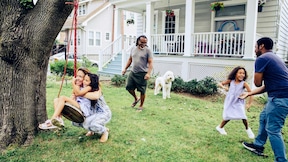New York City Neighborhood Guide

Quick insights
- Living in New York City can offer an enriching experience with plenty of top-employers in Manhattan, world-class parks like Central Park, vast entertainment options and an extensive transit system.
- From the chic sophistication of Carnegie Hill to the quaint cafes and bustling jazz clubs of Greenwich Village, every corner of the city offers a special vibe and charm.
- Whether you prioritize access to parks, schools, cultural landmarks or a vibrant nightlife, conducting research can help first-time homebuyers navigate the homebuying process in New York City.
Introduction to New York City neighborhoods
New York City offers a lively and dynamic experience with diverse neighborhoods catering to all types of people and lifestyles. From the bustling streets of Manhattan to the artistic vibes of Brooklyn, each neighborhood has its own charm. When buying a home in New York City, it can be important to consider a few factors like employment, lifestyle preferences, schools, access to parks and transportation options. The city boasts excellent educational institutions, top-rated healthcare facilities and a thriving job market, especially in Manhattan.
There are five boroughs of New York City: Manhattan, Brooklyn, Queens, The Bronx and Staten Island. In each borough, there are multiple factors at play that help to determine home prices, amenities, entertainment and quality of life. For instance, due to the soaring cost of real estate, neighborhoods in Manhattan tend to have higher home prices compared to other boroughs. Factors influencing home prices can include proximity to amenities and employers, transportation options and neighborhood desirability.
Understanding New York City boroughs
You may be wondering, what is a borough? A borough is a town or administrative division that is part of the city’s governmental structure. As noted above, New York City is composed of five boroughs: Manhattan, Brooklyn, Queens, The Bronx and Staten Island.
- Brooklyn: A distinct borough known for its creativity, diverse neighborhoods and art scene. Brooklyn offers a mix of historic brownstone neighborhoods like Park Slope and Brooklyn Heights. There are many attractions in Brooklyn such as the Brooklyn Bridge, Brooklyn Botanic Garden, Prospect Park and Coney Island.
- Queens: Queens is one of the most ethnically diverse urban areas with immigrant communities and a rich cultural tapestry. Queens offers a mix of residential and commercial areas, from the historic neighborhoods of Astoria and Jackson Heights to the high-energy streets of Flushing. You can also visit the different cultural museums like The Queens Museum or explore the ample green space at Flushing Meadows Corona Park.
- Manhattan: The heart of New York City, known for its iconic skyline and world-renowned landmarks. Manhattan is a global hub for finance, technology and entertainment. From the buzzing streets of Times Square and the financial district of Wall Street to the upscale residential areas of Upper East Side, Manhattan offers a wide array of neighborhoods. You can explore the green oasis of Central Park, take a stunning photo at the Empire State Building or take a ferry ride to Ellis Island. Harlem, located in the northern part of Manhattan, is also renowned for its strong cultural heritage and vibrant community.
- The Bronx: The Bronx is known for its rich history, cultural contributions and green spaces including the largest public park in New York City – Pelham Bay Park. This borough offers a diverse mix of urban and residential communities like the energetic neighborhoods of the South Bronx to the suburban-like areas of Riverdale. You can take the family out for a fun day at the Bronx Zoo or catch a baseball game at Yankee Stadium.
- Staten Island: This borough offers a more relaxed, suburban-like atmosphere. This can be a great place to raise a family due to the quieter, laid-back lifestyle. The borough includes residential areas like St. George. The most popular attractions are the Staten Island Ferry and parks like the Greenbelt and Historic Richmond town.
Largest neighborhoods in New York City
According to Metropolis Moving, as of 2024ftn-6, the largest neighborhoods in New York City by population are:
- Brooklyn
- Queens
- Manhattan
- The Bronx
- Staten Island
Brooklyn
Williamsburg, Bedford-Stuyvesant, Park Slope and Brooklyn Heights. Each neighborhood has its own charm and attractions. Williamsburg is known for its artistic vibe, trendy boutiques and nightlife. Bed-Stuy (Bedford-Stuyvesant) is comprised of brownstone architecture, tree-lined streets and community gardens. Park Slope is a family-friendly neighborhood with quality schools, parks and cultural institutions. Brooklyn Heights is an affluent area with elegant homes and easy access to the Brooklyn Height Promenade and the Brooklyn Bridge, a waterfront park with stunning views.
Queens
Flushing, Astoria and Jackson Heights. Flushing is an electrifying neighborhood with cultural diversity and a wide range of authentic Asian cuisine, from street food to upscale dining options. Astoria has a thriving culinary scene and incredible views of the Manhattan skyline from waterfront parks like Astoria Park. Jackson Heights in a multicultural area with cultural diversity, unique architectural styles including Tudor and a collection of contemporary art at the Queens Museum of Art.
Manhattan
Upper East Side, Upper West Side, Tribeca and Soho. The Upper East Side is a residential area with luxury boutiques. Fashion enthusiasts can shop on Madison Avenue and nature lovers can access the iconic green space at Central Park. The Upper West Side is a family-friendly area featuring the Hudson River Greenway with scenic views and landmarks like the American Museum of Natural History. Tribeca is a fashionable and affluent neighborhood with cobblestone streets, gourmet food markets and the Tribeca Film Festival. Soho is an artistic area with art galleries, shopping centers and nightlife activities. Harlem is home to many iconic landmarks such as the Apollo Theater, Sylvia’s Soul Food Restaurant and the Studio Museum.
The Bronx
Fordham, Morrisania and Parkchester. Fordham is a lively neighborhood known for its historic institutions, bustling shopping area along Fordham Road and New York Botanical Garden. Morrisania is a residential area with a strong cultural heritage and community spirit. You can take your kids to the playground at St. Mary’s Park or cheer on the New York Yankees at Yankee Stadium.
Staten Island
St. George, Great Kills and Tottenville. St. George is a historic neighborhood with a welcoming cultural scene, spectacular waterfront views and transportation hub. Great Kills offers a tranquil suburban lifestyle with outdoor recreation activities and waterfront amenities, making it a great option for families. Tottenville combines historic charm, natural beauty and a strong community atmosphere. The sprawling green spaces, Victorian-style homes and tight-knit neighborhoods can be an appealing option for families with young kids.
Uncovering the stories behind NYC neighborhoods
Each neighborhood has its own unique narrative, shaped by historical events, cultural influences and the people who have called it home. Exploring these stories can provide a deeper understanding and appreciation for the diverse and dynamic nature of NYC.
Hell's Kitchen: The origin of the name
The origin of the name “Hell’s Kitchen” has different theories, but the one prevailing explanation is its rough and chaotic past. Historically, Hell’s Kitchen was an area known for its poverty, crime and gang activity in the late 19th and early 20th centuries. Despite its reputation, Hell’s Kitchen has undergone extreme transformation over the past several years. Today, it’s a thriving neighborhood with trendy restaurants, arts scenes and entertainment options including:
- Restaurant Row: Located along West 46th Street, Restaurant Row is home to an array of eateries, offering cuisines from Italian trattorias and French bistros to Mexican cantinas and Japanese sushi bars.
- Theater District: Hell’s Kitchen is adjacent to Manhattan’s Theater District. The Theater District is known for its world-class theater productions, dazzling marquees and bustling nightlife scene.
Hell’s Kitchen boasts chic boutiques, luxury residential developments and can serve as a testament to the spirit of community that defines New York City.
Tribeca: The meaning behind the name
Tribeca, short for “Triangle Below Canal Street”, is a neighborhood located in Lower Manhattan. The name originates from its geographical location, which forms a triangle-shaped below Canal Street. Historically, the neighborhood was an industrial district with warehouses, factories and loft buildings. It served as a hub for manufacturing and commerce in the 19th and early 20th centuries.
Beginning in the early 1980s, Tribeca underwent redevelopment, with many of its industrial buildings converted into luxury loft apartments, galleries and gourmet dining establishments. Today, Tribeca is one of Manhattan’s most affluent and sought-after neighborhoods, known for its high-end boutiques, cobblestone streets, waterfront location and upscale living spaces.
Tribeca is renowned for its attractions and events including the Tribeca Film Festival. The festival showcases independent films, documentaries and emerging filmmakers.
SoHo: The origin and significance
SoHo is short for “South of Houston Street.” This neighborhood is in Lower Manhattan, New York. Soho was originally home to factories, warehouses and textile lofts.
In the late 20th century, SoHo underwent major developments from an industrial area into an electrifying artistic and commercial hub. In fact, it was the center of the Manhattan art scene during the giddy 1980s. Its cobblestone streets, cast-iron architecture and historical buildings provide a picturesque backdrop for the arts community. Over time, SoHo evolved into a place for high-end shopping with luxury boutiques and designer stores. While it may no longer remain the “it” neighborhood of Manhattan, SoHo still embodies the intersection of art, commerce and creativity.
Additional information for first-time homebuyers
As a first-time homebuyer in New York City, navigating the real estate market can come with its own set of unique challenges. It’s typically a good idea to examine your finances and get a greater understanding of your financial situation, including your ability to afford a down payment, closing costs and ongoing expenses. The homebuying process includes several key steps such as finding a real estate agent, speaking to a New York City home lending advisor, getting preapproved for a home loan in New York City, house hunting, making an offer, due diligence and closing.
There are important factors to consider when choosing a neighborhood:
- Proximity to your job and schools (if you have children)
- Public transportation and nearby amenities
- Condition of the property
- Community atmosphere and neighborhood
Here are a few questions to consider when deciding on a neighborhood in New York City:
- Are you looking for an apartment, condo, co-op, single-family home or multifamily home?
- Do you prioritize outdoor access? What about rooftop access with scenic views of the city?
- Do you want to live on a busy city street close to local businesses and where cultural hotspots are only steps away?
- Do you want to live on a quiet side street with spacious homes, quality schools and a slower pace of life?
Ultimately, the choice is dependent on your individual priorities, preferences and lifestyle needs. Once you’ve narrowed down a list of neighborhoods, you can utilize different resources like government programs, down payment assistance and neighborhood associations.
Conclusion
Understanding the diverse neighborhoods of New York City is essential for first-time homebuyers to find a suitable match for their lifestyle and needs at a price point that is manageable. Each neighborhood offers a distinctive experience, characterized by amenities, transportation options and community atmospheres. By conducting thorough research and partnering with real estate professionals in New York City, homebuyers can pinpoint neighborhoods that align with their preferences.



